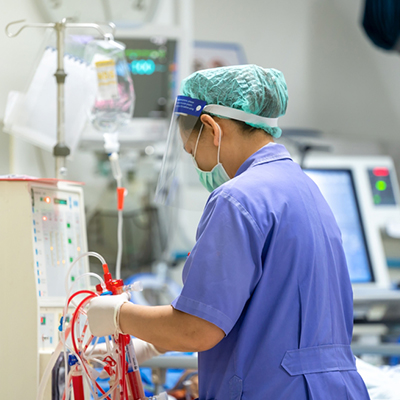CRRT in Anantapur
Continuous Renal Replacement Therapy or CRRT provides continuous dialysis treatment around the clock to assist individuals suffering from renal (kidney) failure. Continuous renal replacement therapy (CRRT) is frequently employed to offer renal support to critically ill patients suffering from acute kidney injury, especially those who exhibit hemodynamic instability. Several techniques are available, each varying in their method of solute clearance. These include continuous venovenous hemofiltration, which primarily utilizes convective solute clearance; continuous venovenous hemodialysis, which focuses on diffusive solute clearance; and continuous venovenous hemodiafiltration, which integrates both dialysis and hemofiltration methods.
Understanding the process
Continuous renal replacement therapy (CRRT) is a specialized form of dialysis utilized for critically ill patients in the intensive care unit (ICU) who are unable to endure conventional dialysis methods. This approach significantly differs from the standard dialysis procedures that many patients may recognize and necessitates advanced skills and knowledge.Traditional hemodialysis is primarily designed as an outpatient treatment, typically administered three times a week for durations of three to four hours per session.

The rapid flow rates employed to eliminate waste products and excess fluid can impose considerable strain on a patient's cardiovascular system, particularly in individuals with pre-existing low or unstable blood pressure or cardiac conditions. In contrast, CRRT operates at a slower pace, thereby minimizing cardiovascular stress. This therapy is conducted continuously over a 24-hour period, allowing for the gradual and consistent removal of waste and fluid from the patient. Additionally, CRRT requires specific anticoagulation measures to prevent clotting within the dialysis circuit.
Who needs a dialysis?
One of the most frequently posed inquiries by patients and their families pertains to dialysis. Their primary concern revolves around the dialysis machine and the potential for kidney function recovery. This may stem from their familiarity with dialysis, which allows them to connect with it more readily than with other treatments administered in the ICU environment. Continuous Renal Replacement Therapy (CRRT) is employed until patients exhibit indications of their kidneys beginning to recover, or until they achieve more stable blood pressure levels that enable them to endure conventional dialysis.
The initial indication of improvement is when a patient begins to produce urine. Many patients undergoing Continuous Renal Replacement Therapy (CRRT) are unable to generate urine due to kidney failure. Nevertheless, even if urine production resumes, the kidneys' ability to filter effectively may take an extended period to recover. It may take several weeks or even months before the kidneys can adequately filter solutes and eliminate waste products.
